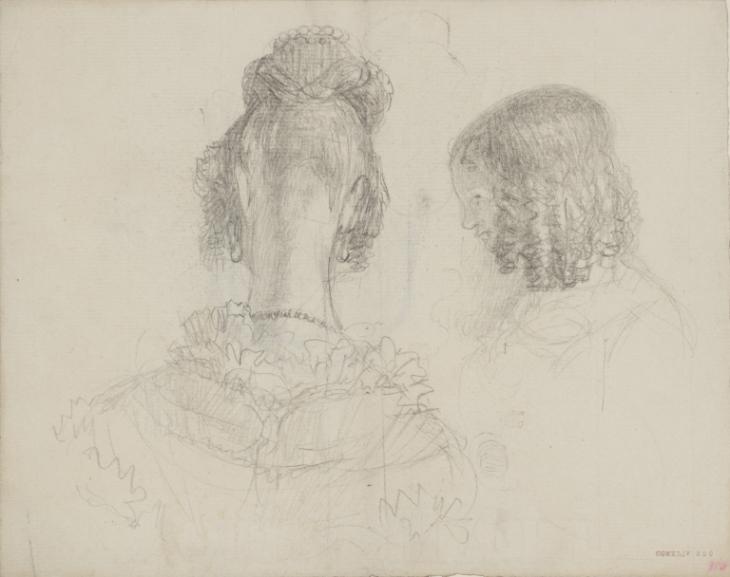Joseph Mallord William Turner Study Related to 'Two Women and a Letter' c.1827-30
Joseph Mallord William Turner,
Study Related to 'Two Women and a Letter'
c.1827-30
Joseph Mallord William Turner 1775–1851
Study Related to ‘Two Women and a Letter’ c.1827–30
D34832
Turner Bequest CCCXLIV 350
Turner Bequest CCCXLIV 350
Pencil on white laid paper, 159 x 201 mm
Watermark ‘John | Hall’
Blind-stamped with Turner Bequest monogram below right of centre
Stamped in black ‘CCCXLIV 350’ bottom right
Watermark ‘John | Hall’
Blind-stamped with Turner Bequest monogram below right of centre
Stamped in black ‘CCCXLIV 350’ bottom right
Accepted by the nation as part of the Turner Bequest 1856
Exhibition history
1989
Turner and the Human Figure: Studies of Contemporary Life, Tate Gallery, London, April–July 1989 (60, as ‘Study of two heads’, c.1827–35, reproduced).
2006
Drawing from Turner, Tate Gallery, November 2006–April 2007 (no catalogue, as ‘Sketch for “Two Women and a Letter”’).
2008
Drawn from the Collection: 400 Years of British Drawing, Tate Britain, London, February 2008–March 2009 (no catalogue, as ‘Sketch for “Two Women and a Letter”’).
References
1830
A.J. Finberg, A Complete Inventory of the Drawings of the Turner Bequest, London 1909, vol.II, p.1141, CCCXLIV 350, as ‘Study of two female heads’, c.1830–41.
1985
Selby Whittingham, ‘What You Will; or some notes regarding the influence of Watteau on Turner and other British Artists (1), Turner Studies, vol.5, no.1, Summer 1985, p.19, ill.22, as ‘Sketches of the Heads of Two Women’, c.1830.
1827
Martin Butlin in Butlin, Mollie Luther and Ian Warrell, Turner at Petworth: Painter and Patron, London 1989, p.93, fig.88, as ‘Sketch for “Two Women and a Letter’, c.1827–35.
1827
Ann Chumbley and Ian Warrell, Turner and the Human Figure: Studies of Contemporary Life, exhibition catalogue, Tate Gallery, London 1989, p.54 no.60, as ‘Study of two heads’, c.1827–35, reproduced).
1989
Evelyn Joll, ‘Exhibition Reviews: Turner and the Human Figure’, Turner Studies, vol.9, no.1, Summer 1989, p.59.
1997
James Hamilton, Turner: A Life, London 1997, reproduced opposite p.111.
This drawing has been related to the richly painted but unfinished Two Women with a Letter (Tate N05501),1 currently dated to about 1830.2 The painting has been seen as a development from the 1827 ink, chalk and gouache blue paper studies Turner made of country house life at John Nash’s East Cowes Castle on the Isle of Wight (Tate; Turner Bequest CCXXVII a) and Lord Egremont’s Petworth House in Sussex (Tate; Turner Bequest CCXLIV), addressed elsewhere in this catalogue. See also the painting of a Music Party, East Cowes Castle (Tate N03550).3
Martin Butlin suggested that the ‘concentration on the back of the neck and the high-swept hair-style of the foremost girl’ in the first painting may derive from the work of Henry Fuseli (1741–1825),4 Professor of Painting at the Royal Academy, who often depicted women with elaborately, even fetishistically, arranged hair, sometimes from the back; see for example Tate N03396 and T10440. He also mentioned a comparable pencil study of a woman in the Seine and Paris sketchbook (Tate D23927; Turner Bequest CCLIV 24),5 now dated to 1832. The Turner and Watteau Scholar Selby Whittingham has described Two Women with a Letter as ‘a more Dutch theme’;6 and while noting Butlin’s mention of Fuseli, he has suggested that the hairstyle was simply the fashion of the day, as seen in the large painting England: Richmond Hill, on the Prince Regent’s Birthday, exhibited in 1819 (Tate N00502),7 and might also derive from one of the recognised influences on that picture and other works by Turner of this period, the French painter of elegant fêtes champêtres, Jean-Antoine Watteau (1684–1721).8
Although Anne Chumbley and Ian Warrell have noted that Turner’s ‘pencil is employed with studied delicacy’,9 Evelyn Joll has suggested that the girl in profile ‘is the reverse of elegant and appears to be nothing more than an ill-favoured brat.’10 Nevertheless, the reflected glow within her shadowed face is carefully and sympathetically observed. While the left-hand figure may well have been a source for the painting, the second figure does not appear, although the features and ringlets of the further woman are not dissimilar in effect. Close examination of the drawing shows the faint beginnings of a third head, between the other two towards the top, with an elementary rendering of the headdress and apparent indications to position the chin and neck, suggesting an abandoned full-face pose.
In 2005, two Chelsea College of Art students participating in Tate Britain’s Drawing from Turner project and exhibition, Emma Puntis and Heeseon Byun, copied the present work, and the latter’s interpretation was exhibited beside it.
There is a slight, unrelated drawing on the verso is Tate D34833 (Turner Bequest CCCXLIV 350v).
Martin Butlin and Evelyn Joll, The Paintings of J.M.W. Turner, revised ed., New Haven and London 1984, p.282 no.448, as c.1835, pl.449 (colour).
Technical notes:
The flattened-out sheet originated in a notebook; stitch holes are evident down the centre, but more so from the verso.
Matthew Imms
August 2016
How to cite
Matthew Imms, ‘Study Related to ‘Two Women and a Letter’ c.1827–30 by Joseph Mallord William Turner’, catalogue entry, August 2016, in David Blayney Brown (ed.), J.M.W. Turner: Sketchbooks, Drawings and Watercolours, Tate Research Publication, February 2017, https://www

